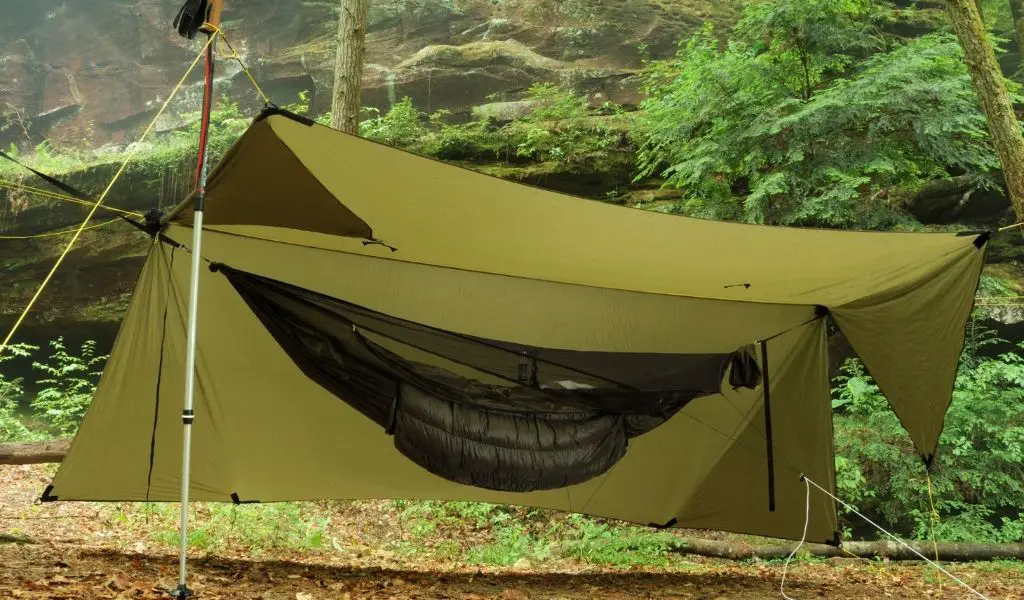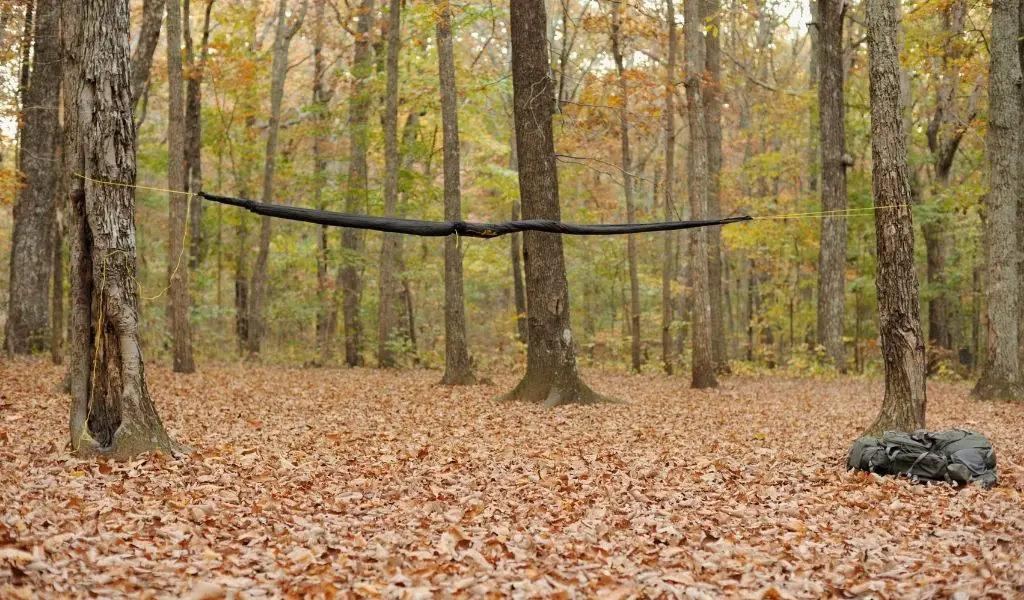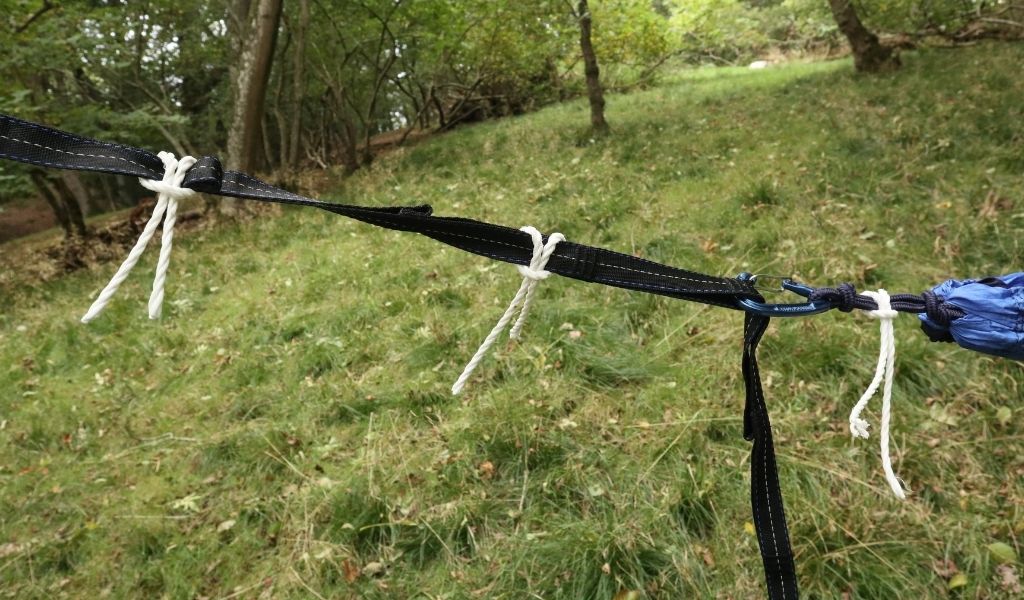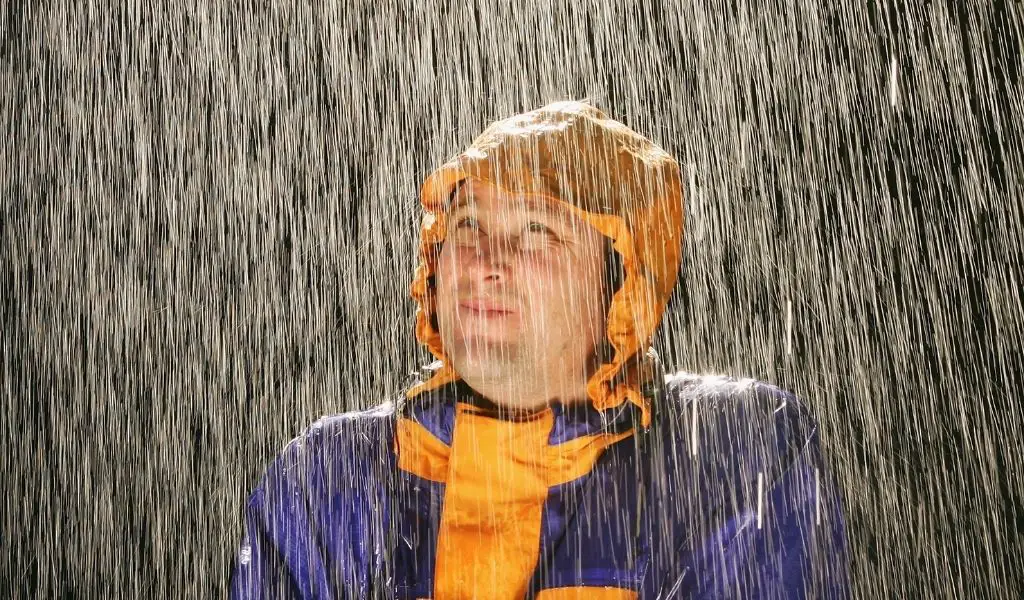Disclaimer: As an affiliate I may earn a commission on any qualifying purchases, including those from Amazon.com, at no extra cost to you – read more.
Unlike camping in a tent where you are closed off from the outdoors, hammock campers are more exposed to the elements and so it takes more techniques and practice to ensure you stay dry.
In this guide, I’ve put together some helpful tips for staying dry while hammock camping, and I’ll answer some common questions about camping in the rain.
- How to Stay Dry in a Hammock
- 1. Get Yourself the Right Tarp
- 2. Pack for All Weather Conditions
- 3. Layer Up
- 4. Practice a Quick Set-Up
- 5. Ensure Your Tarp is Ready to Go
- 6. Choose Your Spot Wisely
- 7. Set Up Your Tarp First
- 8. Pitch According to the Weather
- 9. Driplines (or Water Breaks)
- 10. Keep Wet Clothes Away From Your Hammock
- 11. Get a Gear Hammock
- Related Questions
How to Stay Dry in a Hammock
Here are my 11 top tips for keeping dry in a hammock:
1. Get Yourself the Right Tarp
The main piece of gear that’s going to keep you dry is your tarp (also known as a rain fly). However, not all tarps are made equal. There are different shapes and sizes which each balance performance, ease of set-up, and portability.
Here’s a quick rundown of the different shapes:
- Asymmetrical or Diagonal – These are favored by ultralight backpackers because they are light and compact. They are also easiest to set up as there are few guy lines. However, they have the least coverage with no protection from side rain.
- Hexagonal – A hexagonal tarp sits between asym and rectangular tarps, providing a good balance of coverage, portability, and setup time. If you are buying your first tarp and unsure which shape is best, I’d recommend a hexagonal shape as a good place to start.
- Rectangular – A rectangular or square tarp has a greater coverage area and protects from side wind and rain when angled downwards steeply. They are very versatile although they tend to be heavier and bulkier than the previous two and also take longer to set up.
- Winter Tarp (with doors) – For the most extreme conditions, a tarp with doors offers protection from all directions making them great for stormy winter conditions. However, they are the heaviest, bulkiest, and most expensive.
You should also check the waterproof rating which will be stated in mm. To calculate the rating, they place a 1” diameter tube on top of the tarp and fill it until 3 drops of water seep through.
As a minimum, you’ll want 1,000mm but for heavier weather look for 3,000mm+.
See my full guide to the best hammock tarps for some specific recommendations.
2. Pack for All Weather Conditions
As Benjamin Franklin wisely said, if you fail to prepare, prepare to fail. This applies to hammock camping too.
You need to be prepared for the weather conditions and ensure you have all the right equipment if it rains, here’s a quick summary but you can also check out my full hammock camping gear checklist.
- Tarp (as mentioned above)
- Guy lines and ground stakes for tarp
- Ridgeline
- Underquilt (see recommendations for winter)
- Top quilt
- Driplines (more on this below)
- Waterproof backpack cover
Remember, you’re going to want to have plenty of fast-drying towels on hand too.
3. Layer Up
It’s not just the gear, you should also consider what clothes you are going to pack in order to stay dry. Pack plenty of layers so that you don’t get soaked through to the bone.
The number of recommended layers varies from person to person, however, according to the experts over at REI, you’re going to want to have three layers to work with:
- Base layer: underwear layer to wicks the sweat off your skin
- Middle layer: for insulation to retain body heat and protection from the cold
- Outer layer: shields you from wind and rain to keep you dry
4. Practice a Quick Set-Up
When it’s raining heavily, you don’t want to be learning how to pitch a tarp for the first time. Instead, make sure you get plenty of practice at home before you leave for the trip.
Find some trees near your home and get to work seeing how quickly you can put the tarp up.

5. Ensure Your Tarp is Ready to Go
Practicing is one thing, but you can also set yourself up for success when it comes to quick pitching with these few tips.
Firstly, leave the guy lines on the tarp when you put it away so that you don’t have to mess around with knots. You can wrap them up in a figure of 8 so that they don’t get tangled. Typically, I won’t leave the stakes attached as well but I’ll leave a taut-line hitch at the end where the stake goes.
Secondly, pack your tarp, stakes, and ridgeline on top in your backpack so that you can find them quickly and easily to begin set up straight away. You should pack items that must stay dry at the bottom such as your top quilt and clothing.
6. Choose Your Spot Wisely
Choosing the right spot is a super important and often overlooked step to ensure you stay dry.
You’re going to want to look for a spot under dense tree coverage as this will go some way to reducing the impact of the rain, but you should also look for windbreakers.
A windbreaker is a large natural object such as bushes or rocks that protect against the wind. As well as helping you to stay warm, they will reduce the impact of side wind that can keep you dry.
See my full guide for more tips on staying warm in a hammock.
Of course, you should never choose a spot with any dead branches overhead (we call these widow makers) which could fall down in bad weather.
7. Set Up Your Tarp First

Once you’ve identified the perfect spot, don’t mess around setting up your hammock first, instead, go straight for the tarp.
If you’ve followed tip number 4 and practiced your setup, you should have a good idea of how high to hang the tarp for your hammock.
8. Pitch According to the Weather
When setting up your tarp, you’re going to want to ensure you set it up according to the intensity of the rain.
The more steeply angled your tarp is, the more protection you’ll have from wind and rain and the drier you’ll stay. However, you’ll also have less room to maneuver around.
- When there’s no rain, I like to keep on side of the tarp open using my trekking poles.
- When the rain is light, keep a slight angle so that you still have some room to chill out without getting wet.
- Once it becomes heavy rain, angle your tarp steeply so it’s almost touching your hammock. Do this by shortening the guy lines and moving the stakes closer.
9. Driplines (or Water Breaks)
Once you have got everything set up, the most important thing you need to do to ensure you stay dry all night is set up drip lines.
Drip lines are small pieces of cord that you set up on your hammock suspension. The idea is that as the water runs down the ropes or straps from the exposed end, it hits the drip line and runs off vertically rather than continuing down into your hammock.

You don’t need anything fancy here, just some small pieces of cord or shoelace as shown in the above image. However, if you prefer to buy all your gear, ENO make some ready-made drip strips that clip onto their hammock straps.
Drip lines are the most effective form of water break, although you can also use pieces of cloth or other items from your backpack if you don’t have any drip lines to hand.
10. Keep Wet Clothes Away From Your Hammock
You should always change into dry clothes when getting into your hammock and leave your wet clothes elsewhere. If you have room, it’s best to hang them up under your tarp this is best.
Some camping experts suggest putting wet clothes in your sleeping bag to dry them out due to the warmth generated. Regardless of whether this works for tent camping, you should not try this when hammock camping.
Not only will you catch a chill that could be amplified by the fact you are hanging off the ground rather than lying on the floor, but it can degrade the loft in your down.
11. Get a Gear Hammock
Finally, you want to make sure your gear stays dry. In light rain, you can get away with keeping your backpack under the tarp next to your hammock. However, when it gets heavy, you’re going to want to store your belongings off the ground so that they stay dry.
For this, I recommend you get a gear hammock (also known as a gear sling). These are like a mini hammock that sit below your hammock to keep your backpack in.
It attaches to your hammock straps and sits in the middle so that it doesn’t cause any unbalance. I recommend the ENO gear sling which comes with a built-in storage sack similar to their hammocks.
Find some other tips such as where to store your boots in my full guide to storing your gear while hammock camping.
Related Questions
How Do I Stop Rain Running Down My Hammock Straps?
The best way to stop rain running down your hammock strap is to use drip lines. These are small pieces of cord or rope that you set periodically on your straps to allow the water to run off vertically before it hits your hammock.
Are Hammocks Waterproof?
Whilst most leisure hammocks are not waterproof, those that have been designed especially for camping do have some level of water resistance thanks to the use of synthetic materials like nylon and polyester and the addition of waterproof coatings.
How To Keep Gear Dry When Hammock Camping?
You can keep your gear dry whilst hammock camping by ensuring it is stored off the ground and underneath your tarp. The best way to do this is with a gear hammock or gear sling which sits alongside your main hammock.



